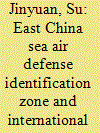| Srl | Item |
| 1 |
ID:
154652


|
|
|
|
|
| Summary/Abstract |
China's declaration of an air defense identification zone (ADIZ) in the East China Sea shocked the international community, and many explanations have been offered about the motivation behind it. We argue that domestic politics played a key role in the ADIZ policy. However, existing studies have not paid sufficient attention to decisionmakers' political motivation. To fill this gap, we explore two distinct models: the diversionary foreign policy model and the mobilization model. Both models focus on the linkage between the state leader's domestic political consideration and foreign policy behavior, but each has different theoretical and empirical implications. Our findings suggest that the mobilization model offers a better explanation of the motivation for China's move.
|
|
|
|
|
|
|
|
|
|
|
|
|
|
|
|
| 2 |
ID:
139152


|
|
|
|
|
| Summary/Abstract |
Originating at the height of the Cold War, Air Defense Identification Zones (ADIZs), i.e. non-territorial airspace unilaterally designated by States for aircraft identification, had not encountered substantial protests until China's declaration of the East China Sea ADIZ in November 2013. Debates center not on the right to establish the ADIZ per se, but primarily on the purported application of identification rules to traversing aircraft, its overlap with pre-existing ADIZs claimed by other States, and the coverage of contested islands and rocks. This article argues that the identification of traversing civil aircraft does not jeopardize the paramount safety of international civil aviation, imposes only slight burden upon civil aircraft, and has garnered wide compliance. The identification of traversing military aircraft is a legitimate measure for coastal States to safeguard their security interest, and is constantly conducted by many States on a de facto basis. The overlap with ADIZs of other States and coverage of contested islands and rocks do not contradict international law and are legitimate measures for the maintenance of maritime and territorial interests. It is further suggested that all relevant States should negotiate mutually acceptable arrangements to avoid miscalculation and escalation, and to minimize confusions and inconveniences caused to third-party States.
|
|
|
|
|
|
|
|
|
|
|
|
|
|
|
|